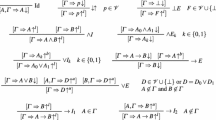Abstract
Theorem proving procedures for the propositional calculus have traditionally relied on syntactic manipulations of the formula to derive a proof. In particular, clausal theorem provers sometimes lose some of the obvious semantics present in the theorem, in the process of converting the theorem into an unnatural normal form. Most existing propositional theorem provers do not incorporate substitution of equals for equals as an inference rule. In this paper we develop a “natural” proof system for the propositional calculus, with the goal that most succinct mathematical proofs should be encodable as short formal proofs within the proof system.
The main distinctive features of NPS are:
-
1.
The substitution principle for the equivalence connective is incorporated as an inference rule.
-
2.
A limited version of the powerful ideas of extension, originally suggested by Tseitin, are exploited. Extension allows the introduction of auxiliary variables to stand for intermediate sub-formulas in the course of a proof.
-
3.
Formulas are standardized by converting them into a normal form, while at the same time preserving the explicit semantics inherent in the formula.
-
4.
A generalization of the semantic tree approach is used to perform case analysis on literals as well as sub-formulas.
-
5.
Additional enhancements such as a generalization of resolution are suggested.
We show that from a complexity theoretic viewpoint NPS is at least as powerful as the resolution procedure. We further demonstrate formulas on which NPS fares better than resolution. Finally, since proofs in NPS usually resemble manual proofs, we feel that NPS is easily amenable to an interactive theorem prover.
Access this chapter
Tax calculation will be finalised at checkout
Purchases are for personal use only
Preview
Unable to display preview. Download preview PDF.
Similar content being viewed by others
References
S.K. Abdali and D.R. Musser, “A Proof Method based on Sequents and Unification,” Unpublished Manuscript (1982), G.E. R and D Center, Schenectady, NY.
W. Bibel, “Tautology Testing with a Generalized Matrix Reduction Method,” Theoretical Computer Science, 8 (1979), pp.31–44.
C-L Chang and R.C. Lee, Symbolic Logic and Mechanical Theorem Proving. Academic Press (1973), New York.
S. A. Cook and R. A. Reckhow, “The Relative Efficiency of Propositional Proof Systems,” J. of Symbolic Logic, 44 (1979), pp. 36–50.
J. Hsiang, Topics in Automated Theorem Proving and Program Generation. Ph.D. Thesis, Department of Computer Science, University of Illinois, Urbana, Illinois.
J. Hsiang and N. Dershowitz, “Rewrite Methods for Clausal and Non-clausal Theorem Proving,” Proc. 10th EATCS Intl. Collq. on Automata, Languages, and Programming, (1983), Spain.
S.C. Kleene, An Introduction to Metamathematics. (1952), Van Nostrand, New York.
R. Kowalski and P. Hayes, “Semantic Trees in Automatic Theorem Proving,” in Machine Intelligence 4, Meltzer and Michie, eds., Edinburgh Univ. Press, Edinburgh.
B. Krishnamurthy, “Short Proofs for Tricky Formulas,” Unpublished Manuscript, (1982), G.E. R and D Center, Schenectady, NY.
B. Krishnamurthy and R. N. Moll, “Examples of Hard Tautologies in the Propositional Calculus,” Proc. of the Thirteenth ACM Symp. on Th. of Computing, (1981), pp. 28–37.
B. Monien and E. Speckenmeyer, “3-Satisfiability is Testable in O(1.62r) Steps,” Bericht Nr. 3/1979 (1979), GH Paderborn, Fachbereich Mathematik-Informatik.
J.A. Robinson, “A Machine Oriented Logic Based on the Resolution Principle,” JACM, 12 (1965), pp. 23–41.
G. S. Tseitin, “On the Complexity of Derivations in Propositional Calculus,” Structures in Constructive Mathematics and Mathematical Logic, Part II, A. O. Sliosenko, ed., (1968), pp. 115–125.
Author information
Authors and Affiliations
Editor information
Editors and Affiliations
Rights and permissions
Copyright information
© 1984 Springer-Verlag Berlin Heidelberg
About this paper
Cite this paper
Kapur, D., Krishnamurthy, B. (1984). A Natural Proof System Based on Rewriting Techniques. In: Shostak, R.E. (eds) 7th International Conference on Automated Deduction. CADE 1984. Lecture Notes in Computer Science, vol 170. Springer, New York, NY. https://doi.org/10.1007/978-0-387-34768-4_3
Download citation
DOI: https://doi.org/10.1007/978-0-387-34768-4_3
Publisher Name: Springer, New York, NY
Print ISBN: 978-0-387-96022-7
Online ISBN: 978-0-387-34768-4
eBook Packages: Springer Book Archive




